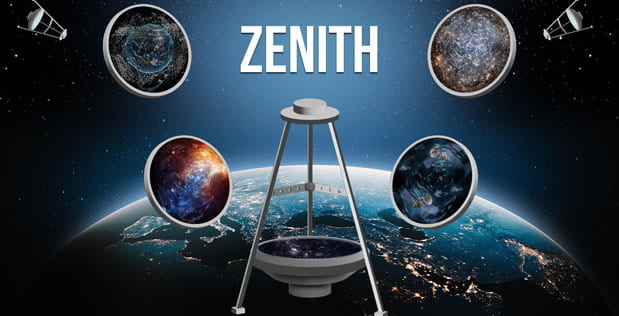
Image courtesy of Defense Advanced Research Projects Agency (DARPA)
The Low-Gravity Science and Technology Lab is working with Honeywell Aerospace and Soter Technology to design a self-assembling liquid mirror telescope with off-axis tilting and slewing capabilities. The effort, supported by the DARPA Zenith Program, explores the use of Halbach arrays, a particular arrangement of permanent magnets that produces one-sided magnetic fields, to manipulate ferrofluids to the desired optical shape. The ferrofluid, in combination with immiscible ionic liquids containing reflective nanoparticles, is forced to create a pristine liquid mirror surface. Such innovation has potential for both terrestrial and orbital deployment, alongside the advantage of off-axis observation in contrast to traditional liquid mirror telescopes.
Our team at Georgia Tech is in charge of the modeling, simulation, and optimization of the magnetic system, alongside the prototyping of a 0.1 m diameter liquid mirror telescope. By means of numerical and analytical approaches, an optimized design utilizing the concept of a Halbach array will be developed and manufactured. The Halbach array generates equipotential lines parallel to its surface, overcoming the force of gravity for a ground-based liquid mirror telescope through the adjustment of internal magnetic configurations. Ultimately, it produces a mirror surface with the desired optical shape, all while maintaining an acceptable wavefront error.

The team post-PDR at Honeywell’s offices in Chicago
Student leads:
Shay Vitale, Janoah Dietrich, Filippo di Benedetto, Hugh Chen
Conference Papers & Presentations:
- N. Rowlands, Á. Romero-Calvo, D. Stafford, R. Kamire, A. Childers, S. F. Yates, E. Rahislic, S. Zheng, P. Cameron, G. Cano-Gómez, H. Chen, T. Hu, E. Comstock, M. Herrada, “Development of a self-assembling ferrofluidic ionic liquid mirror“, In SPIE Astronomical Telescopes + Instrumentation, June 16–21, 2024, doi: 10.1117/12.3020718
- K. Iyer, M. Nayak, D. Brousseau, A. Childers, T. Hisakado, K. Kadala, R. Kamire, Y. Li, D. Mariappan, G. Radighieri, A. Romero-Calvo, N. Rowlands, P. Schroeder, G. Tarkenton, S. Thibault, D. Vollmer, and S. Basu, “Zenith: DARPA’s Liquid Mirror Telescope Program“, In SPIE Astronomical Telescopes + Instrumentation, Yokohama, JP, June 16–21, 2024, doi: 10.1117/12.3020080

